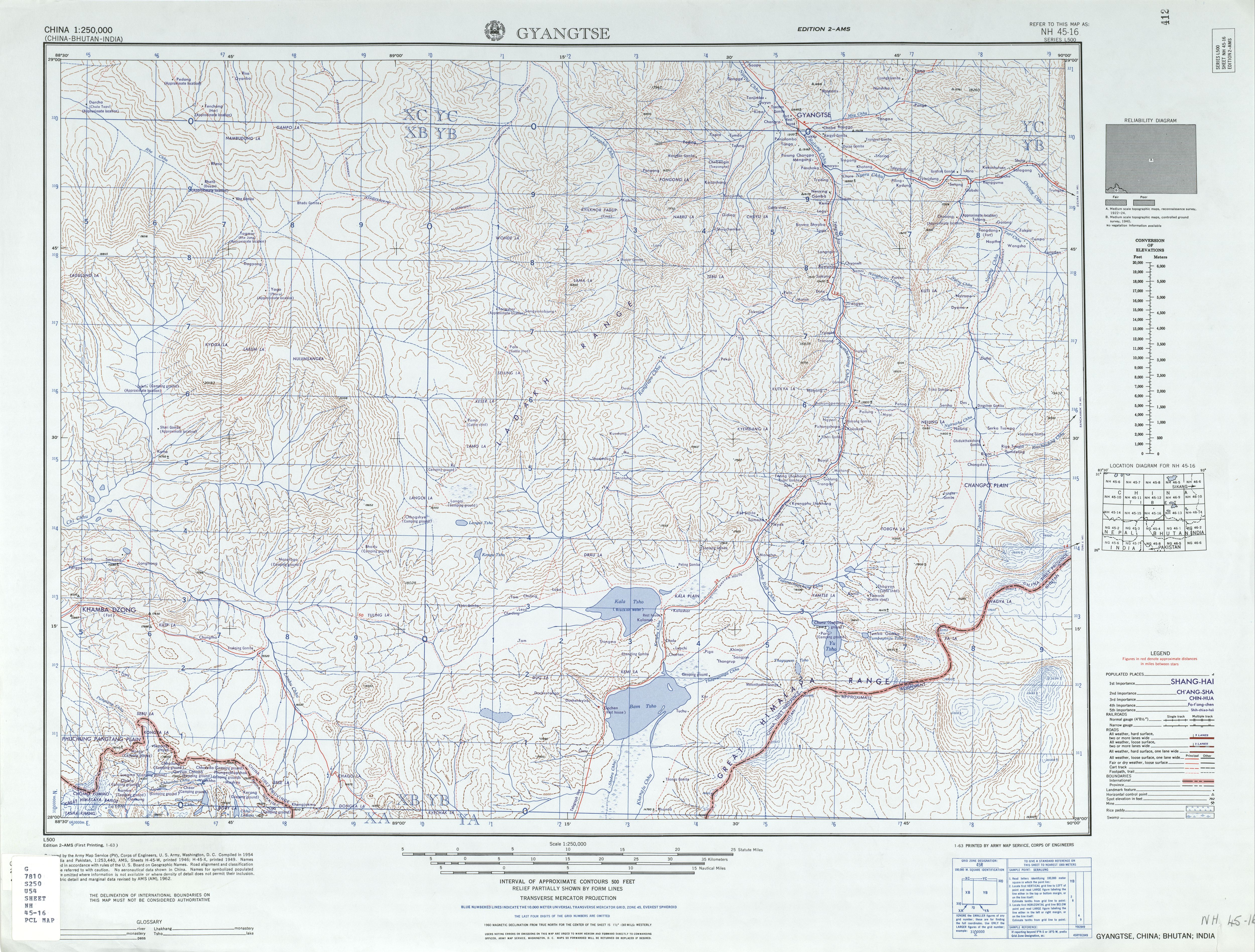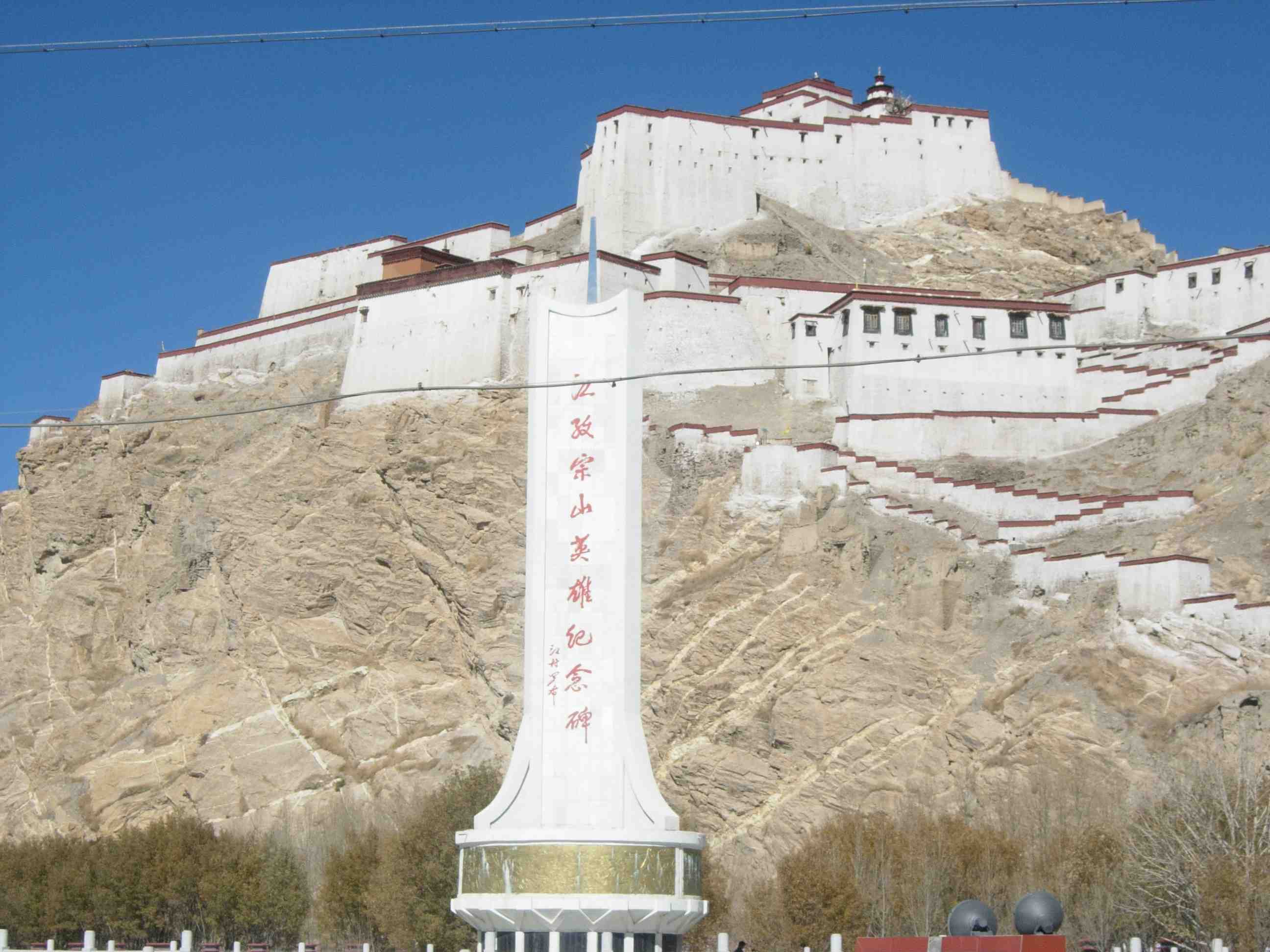|
Gyangtse
Gyantse, officially Gyangzê Town (also spelled Gyangtse; ; ), is a town located in Gyantse County, Shigatse Prefecture, Tibet Autonomous Region, China. It was historically considered the third largest and most prominent town in the Tibet region (after Lhasa, and Shigatse), but there are now at least ten larger Tibetan cities. Location The town is strategically located in the Nyang Chu valley on the ancient trade routes from the Chumbi Valley, Yatung and Sikkim, which met here. From Gyantse, routes led to Shigatse downstream and also over the Kora La (Pass) to Central Tibet. The fortress (constructed in 1390) guarded the southern approaches to the Yarlung Tsangpo Valley and Lhasa. The town was surrounded by a wall 3 km long.Buckley, Michael and Strauss, Robert (1986), p. 158. Demographics In 1952, Gyantse had a population of perhaps 8,000 people, about the same as in 2008. It is 3,977 meters (13,050 ft) above sea level, and is located 254 km southwest of Lhasa in th ... [...More Info...] [...Related Items...] OR: [Wikipedia] [Google] [Baidu] |
Gyantse County
Gyantse County officially Gyangzê County (; ) is a county of Xigazê in the Tibet Autonomous Region. Its main settlement is Gyantse Town known for its monasteries. Town and townships 1 town and 18 townships: * Gyangzê (Gyantse) Town (, ) * Naröl Township (, ) * Kardoi Township (, ) * Karmai Township (, ) * Tsangkha Township (, ) * Rinang Township (, ) * Dagzê Township (, ) * Rasog Township (, ) * Drongtsé Township (, ) * Lungmar Township (, ) * Tsechen Township (, ) * Jangra Township (, ) * Nyangdoi Township (, ) * Kangco Township (, ) * Gyinkar Township (, ) * Rizhing Township (, ) * Ralung Township (, ) * Charing Township Charing is a village and civil parish in the Ashford District of Kent, in south-east England. It includes the settlements of Charing Heath and Westwell Leacon. It is located at the foot of the North Downs and reaches up to the escarpment. T ... (, ) * Jaggyê Township (, ) Climate References Counties of Tibet Shiga ... [...More Info...] [...Related Items...] OR: [Wikipedia] [Google] [Baidu] |
Gyantse With Kumbum & Fort - Edited
Gyantse, officially Gyangzê Town (also spelled Gyangtse; ; ), is a town located in Gyantse County, Shigatse Prefecture, Tibet Autonomous Region, China. It was historically considered the third largest and most prominent town in the Tibet region (after Lhasa, and Shigatse), but there are now at least ten larger Tibetan cities. Location The town is strategically located in the Nyang Chu valley on the ancient trade routes from the Chumbi Valley, Yatung and Sikkim, which met here. From Gyantse, routes led to Shigatse downstream and also over the Kora La (Pass) to Central Tibet. The fortress (constructed in 1390) guarded the southern approaches to the Yarlung Tsangpo Valley and Lhasa. The town was surrounded by a wall 3 km long.Buckley, Michael and Strauss, Robert (1986), p. 158. Demographics In 1952, Gyantse had a population of perhaps 8,000 people, about the same as in 2008. It is 3,977 meters (13,050 ft) above sea level, and is located 254 km southwest of Lhasa in th ... [...More Info...] [...Related Items...] OR: [Wikipedia] [Google] [Baidu] |
Palcho Monastery
The Palcho Monastery or Pelkor Chode Monastery or Shekar Gyantse is the main monastery in the Nyangchu river valley in Gyantse, Gyantse County, Shigatse Prefecture, Tibet Autonomous Region. The monastery precinct is a complex of structures which, apart from the Tsuklakhang Monastery, also includes its Kumbum, believed to be the largest such structure in Tibet,Neville-Hadley p.771 quote:the nine story Kumbum the largest chorten in Tibet. that is most notable for its 108 chapels in its several floors and the old Dzong or fort. History The earliest history of the Penchor Chode Monastery is traced to the ninth century. Pelkhor-tsen, son of Langdarma (anti Buddhist King of West Tibet) after whom the monastery is named as Pelkor Chode, lived here and attempted to perpetuate the Yarlung dynasty of his father who had been assassinated.Dorje p.156 Gyantse town was established between the 14th and 15th centuries as a feudatory, with the Sakya sect playing a crucial overlord role. During ... [...More Info...] [...Related Items...] OR: [Wikipedia] [Google] [Baidu] |
Friendship Highway (China-Nepal)
There are several highways sometimes known as Friendship highways. Note that the "friendship" name may not in all cases necessarily be the current official name or common name. * China-Laos Friendship Highway, 1963 (Chinese 中老友谊公路) * China-Nepal Friendship Highway, 1967 (Chinese 中尼友谊公路), highway connecting the Chinese Tibet Autonomous Region with Nepal *China-Pakistan Friendship Highway (Chinese 中巴友誼公路), better known as the Karakoram Highway *China-Vietnam Friendship Highway (Chinese 中越友谊公路) *Mittraphap Road (Thailand Route 2), literally "Friendship Road" * Khmer-American Friendship Highway (National highway 4), Cambodia *Philippine-Japan Friendship Highway The Pan-Philippine Highway, also known as the Maharlika Highway ( tl, Daang Maharlika; ceb, Dalang Halangdon), is a network of roads, expressways, bridges, and ferry services that connect the islands of Luzon, Samar, Leyte, and Mindanao in t ..., Philippines * Bangladesh-Myanm ... [...More Info...] [...Related Items...] OR: [Wikipedia] [Google] [Baidu] |
Cultural Revolution
The Cultural Revolution, formally known as the Great Proletarian Cultural Revolution, was a sociopolitical movement in the People's Republic of China (PRC) launched by Mao Zedong in 1966, and lasting until his death in 1976. Its stated goal was to preserve Chinese communism by purging remnants of capitalist and traditional elements from Chinese society. The Revolution marked the effective commanding return of Mao –who was still the Chairman of the Chinese Communist Party (CCP)– to the centre of power, after a period of self-abstention and ceding to less radical leadership in the aftermath of the Mao-led Great Leap Forward debacle and the Great Chinese Famine (1959–1961). The Revolution failed to achieve its main goals. Launching the movement in May 1966 with the help of the Cultural Revolution Group, Mao charged that bourgeois elements had infiltrated the government and society with the aim of restoring capitalism. Mao called on young people to "bombard the headqu ... [...More Info...] [...Related Items...] OR: [Wikipedia] [Google] [Baidu] |
Gyantse Fortress
Gyantse Dzong or Gyantse Fortress is one of the best preserved dzongs in Tibet, perched high above the town of Gyantse on a huge spur of grey brown rock.French (1994), p. 227. According to Vitali, the fortress was constructed in 1390 and guarded the southern approaches to the Tsangpo Valley and Lhasa. The town was surrounded by a wall long.Buckley, Michael and Strauss, Robert (1986), p. 158. The entrance is on the eastern side. Early history The original fortress, known as Gyel-khar-tse was attributed to Pelkhor-tsen, son of the anti-Buddhist king Langdharma, who probably reigned from 838 to 841 CE. The present walls were supposedly built in 1268, after the rise in power of the Sakyapa sect. A large palace was built in 1365 by a local prince, Phakpa Pelzangpo (1318–1370), who had found favour campaigning for the Sakyapas in the south. He also brought a famous Buddhist teacher, Buton Rinchendrub of Zhalu, to live in a temple there. Later in the 14th century Phakpa Pelzangpo ... [...More Info...] [...Related Items...] OR: [Wikipedia] [Google] [Baidu] |
Sakya (Tibetan Buddhist School)
The ''Sakya'' (, 'pale earth') school is one of four major schools of Tibetan Buddhism, the others being the Nyingma, Kagyu, and Gelug. It is one of the Red Hat Orders along with the Nyingma and Kagyu. Origins Virūpa, 16th century. It depicts a famous episode in his hagiography when he stopped the sun in the sky. The name ''Sakya'' ("pale earth") derives from the unique grey landscape of the Ponpori Hills in southern Tibet near Shigatse, where Sakya Monastery, the first monastery of this tradition, and the seat of the Sakya School was built by Khon Konchog Gyalpo (1034–1102) in 1073. The Sakya tradition developed during the second period of translation of Buddhist scripture from Sanskrit into Tibetan in the late 11th century. It was founded by Drogmi, a famous scholar and translator who had studied at the Vikramashila directly under Naropa, Ratnākaraśānti, Vagishvakirti and other great panditas from India for twelve years. Khon Konchog Gyalpo became Drogmi's disc ... [...More Info...] [...Related Items...] OR: [Wikipedia] [Google] [Baidu] |
Chörten
A stupa ( sa, स्तूप, lit=heap, ) is a mound-like or hemispherical structure containing relics (such as ''śarīra'' – typically the remains of Buddhist monks or nuns) that is used as a place of meditation. In Buddhism, circumambulation or ''pradakhshina'' has been an important ritual and devotional practice since the earliest times, and stupas always have a ''pradakhshina'' path around them. The original South Asian form is a large solid dome above a tholobate or drum with vertical sides, which usually sits on a square base. There is no access to the inside of the structure. In large stupas there may be walkways for circumambulation on top of the base as well as on the ground below it. Large stupas have or had ''vedikā'' railings outside the path around the base, often highly decorated with sculpture, especially at the torana gateways, of which there are usually four. At the top of the dome is a thin vertical element, with one of more horizontal discs spreading ... [...More Info...] [...Related Items...] OR: [Wikipedia] [Google] [Baidu] |
Kumbum
A Kumbum ( "one hundred thousand holy images") is a multi-storied aggregate of Buddhist chapels in Tibetan Buddhism. The most famous Kumbum forms part of Palcho Monastery. The first Kumbum was founded in the fire sheep year 1427 by a Gyantse prince. It has nine ''lhakang''s or levels, is high surmounted by a golden dome, and contains 77 chapels which line its walls. Many of the statues were damaged during the Cultural Revolution but have since been replaced with clay images, though they lack the artistic merit of the originals. The 14th century murals showing Newar and Chinese influences, survived much better. The Kumbum or great ''gomang'' ("many-doored") stupa at Gyantse is a three-dimensional mandala meant to portray the Buddhist cosmos. The Kumbum, like other mandalas, which are portrayed by a circle within a square, enables the devotee to take part in the Buddhist perception of the universe and can depict one's potential as they move through it. Mandalas are meant to aid ... [...More Info...] [...Related Items...] OR: [Wikipedia] [Google] [Baidu] |
World War II
World War II or the Second World War, often abbreviated as WWII or WW2, was a world war that lasted from 1939 to 1945. It involved the vast majority of the world's countries—including all of the great powers—forming two opposing military alliances: the Allies and the Axis powers. World War II was a total war that directly involved more than 100 million personnel from more than 30 countries. The major participants in the war threw their entire economic, industrial, and scientific capabilities behind the war effort, blurring the distinction between civilian and military resources. Aircraft played a major role in the conflict, enabling the strategic bombing of population centres and deploying the only two nuclear weapons ever used in war. World War II was by far the deadliest conflict in human history; it resulted in 70 to 85 million fatalities, mostly among civilians. Tens of millions died due to genocides (including the Holocaust), starvation, ma ... [...More Info...] [...Related Items...] OR: [Wikipedia] [Google] [Baidu] |



.jpg)



